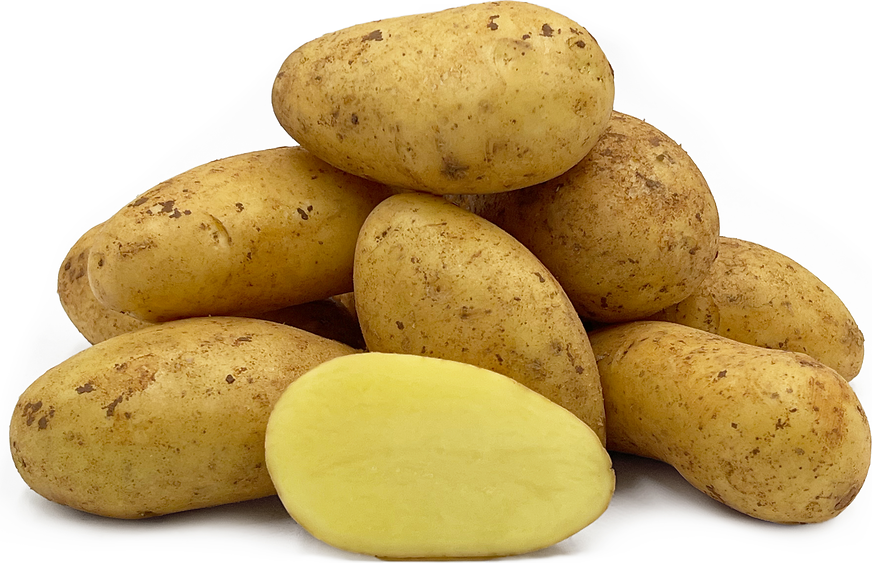


Annabelle Potatoes
Estimated Inventory, lb : 0
Description/Taste
Annabelle potatoes are a small to medium-sized varietal with a long, oval to elliptical appearance. The tubers are mostly uniform in shape and have thin, smooth skin with shallow, flat eyes. The skin ranges in color from pale yellow, cream-colored, to yellow-tan and is sometimes speckled with brown markings and spots, depending on cultivation. Underneath the surface, the golden yellow flesh is firm, dense, and fine-grained with a slippery feel. Annabelle potatoes must be cooked and emit a savory, earthy aroma when heated. The potatoes are high in water and low in starch, giving the flesh a waxy consistency with a creamy, smooth, and slightly chewy mouthfeel. Annabelle potatoes bear a mild, sweet, earthy, and somewhat nutty flavor.
Seasons/Availability
Annabelle potatoes are available year-round, with a peak season in the late summer through early fall.
Current Facts
Annabelle potatoes, botanically classified as Solanum tuberosum, are an early season variety belonging to the Solanaceae or nightshade family. The modern potato cultivar was developed in the late 20th and early 21st centuries in Europe and was selected as a commercial variety, favored for its high yields, easy-to-grow nature, disease resistance, appearance, and flavor. Annabelle potatoes are generally harvested between 70 to 90 days, and each plant can develop up to 36 potatoes, depending on space, soil, and environment. Since their release, Annabelle potatoes have become a favorite cultivar among chefs. The tubers have a relatively uniform shape and size, are versatile, and contribute sweet, nutty, and earthy flavors to savory culinary dishes. Annabelle potatoes are also offered as seed potatoes, making them a popular home garden variety throughout Europe for their fast-growing nature and high yields.
Nutritional Value
Annabelle potatoes are a source of fiber to regulate the digestive tract, vitamin C to strengthen the immune system, and iron to develop the protein hemoglobin for oxygen transport through the bloodstream. The potatoes also provide potassium to balance fluid levels within the body, calcium to build strong bones and teeth and contain other nutrients, including vitamin B6, manganese, and folate.
Applications
Annabelle potatoes have a mild, sweet, and subtly nutty flavor well suited for cooked preparations. The waxy potato holds its shape well and has a firm but smooth consistency, lending itself to salads and boiled recipes. Annabelle potatoes are also used in soups, stews, and curries, steamed as a side dish, or oven-roasted as an accompaniment to grilled meats. The variety’s dense texture allows it to be baked, fried, or pan-fried. Annabelle potatoes can also be incorporated into gratins and casseroles, pressed and fried into potato pancakes, or used in any recipe calling for waxy potatoes. While less common, some chefs value the variety for mashed potatoes. Annabelle potatoes pair well with aromatics such as garlic, onions, and shallots, herbs including chives, mint, dill, and coriander, legumes, zucchini, squash, carrots, cheeses such as cheddar, parmesan, and asiago, and spices including garam masala, turmeric, curry powder, and paprika. Whole, unwashed Annabelle potatoes should be kept in a cool, dry, and dark location. The potatoes do not have a long storage life and should be used within a few weeks after purchase.
Ethnic/Cultural Info
In 2012, Annabelle potatoes were heavily marketed throughout Germany as a family potato. The slogan “Annabelle, die Familienkartoffel,” translating to mean “Annabelle, the Family Potato,” was featured on the potato’s packaging, marketing materials, and website. The website also had recipes for the variety, along with games for kids and adults to enjoy. This marketing push successfully established Annabelle potatoes as a standard variety sold in grocery stores across Germany. Germany's consumer markets focus on the potato’s name rather than function, making effective branding essential to the variety’s success.
Geography/History
Annabelle potatoes were developed in Metslawier, the Netherlands, through HZPC, a potato breeding company, in the 1990s. The variety was created through a cross between nicola and monalisa potatoes and was selected as a commercial cultivar for its early season, disease resistance, flavor, and yields. Annabelle potatoes were released in 2001 and were listed in several international catalogs by 2002. Throughout the 21st century, Annabelle potatoes have become a favored early potato cultivated in regions across Europe, including Southern Germany, Finland, the Netherlands, and France. The variety is sold in consumer markets in over fourteen countries and was also introduced to Canada, where it was trialed and studied for over six years before being released. W.P. Griffin exclusively grows and disperses Annabelle potatoes in Canada. Today Annabelle potatoes are cultivated throughout Europe, New Zealand, and Canada offered through select retailers, specialty grocers, and direct from growers.








